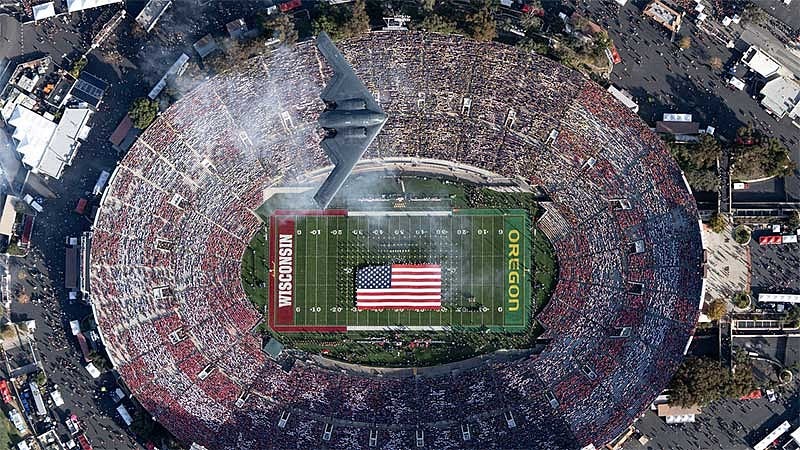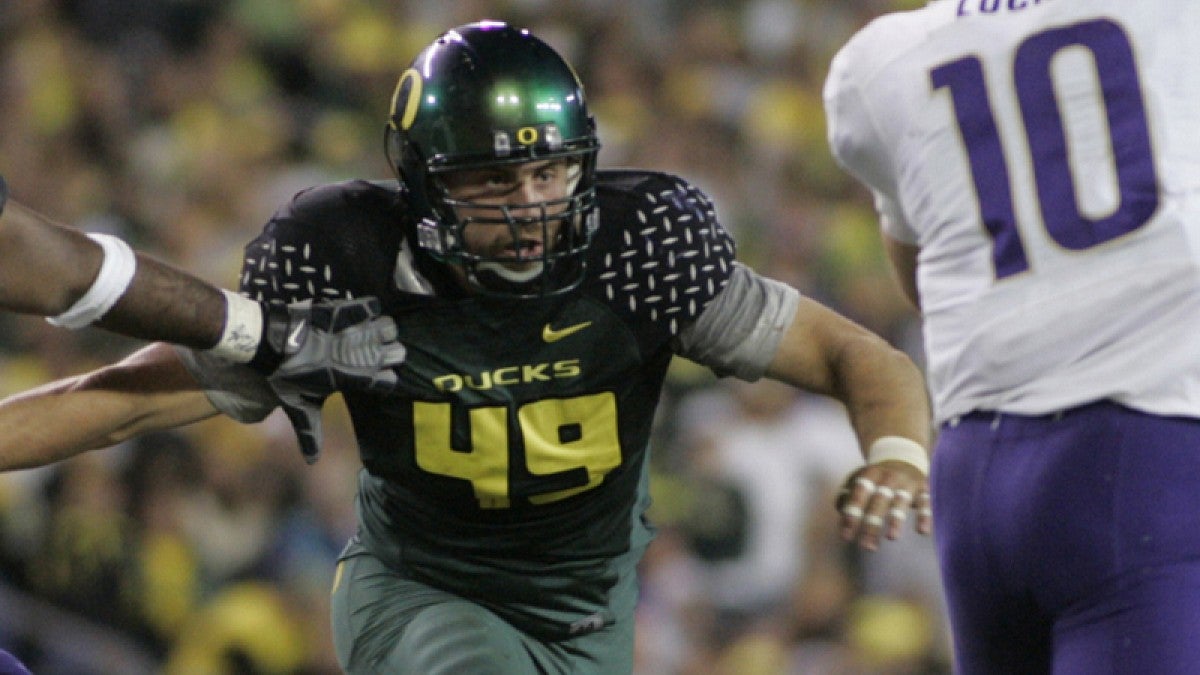The last time Nick Reed, a 2008 history graduate, was on the Rose Bowl Stadium field, he was picking up a pair of sacks for the Ducks in a conference game against UCLA.
The year was 2007, and Reed was a revelation on the defensive line for the UO. The Pac-10 first-team, All-Conference player led the league and ranked third nationally in tackles for loss and was tops among all Ducks with 12 sacks. He was named the Walter Camp Football Foundation National Player of the Week after the Washington State game, was a finalist for the Ted Hendricks Award as the nation’s top defensive end, and was named second-team All-American.
It wasn’t easy to stand out on a defense that included T.J. Ward, Walter Thurmond III, Patrick Chung and Casey Matthews, but Reed did it.
And, it turns out, he was just warming up.

He earned the Morris Trophy as the Pac-10’s best defensive lineman, was voted the team’s most outstanding player by his teammates, was a finalist for the Campbell Trophy — the “Academic Heisman,” which was then known as the Draddy Trophy — and became just the second Duck to earn first-team All-America honors on the field and in the classroom.
The 13 sacks in 2008 still stand as the UO single-season record, as does his career total of 29.5. He also ranks second in UO history in career tackles for loss with 51.5, single-season tackles for loss with 22.5, single-game tackles for loss with 5, twice, single-game sacks with 3.5, twice, and single-season sacks with 12, where he is second only to himself.
Reed was drafted by the Seattle Seahawks in 2009 — the National Football League team also chose UO teammate Max Unger in the same draft — and he went on to play for the Seahawks, Chicago Bears, Tampa Bay Buccaneers and Minnesota Vikings. With the Seahawks, he managed a feat he never achieved at the UO, scoring a touchdown on a 79-yard fumble recovery against the Jacksonville Jaguars.
But his NFL career did not pan out as he hoped, and by the end of the 2012 season he was out of the game entirely, and looking for a new challenge.
“Growing up, my dad was a flight surgeon in the Navy, so he’s a doctor who works with pilots but also flies,” Reed said. “He’d come home and tell me about the pilots he was working with and the airplanes he got to fly or they got to fly. Even from a very young age I was interested in being a pilot, well before I found out I was even decent at football.
“Once I realized my NFL career was coming to a close I had to get a real job. I liked flying, and I liked moving to new cities and meeting new people, so the Air Force was an easy choice for me,” he said.
Reed enlisted in the U.S. Air Force in 2013, and the UO’s 2008 team captain is now Captain Nicholas Reed, a B-2 Spirit Aircraft commander and nuclear plans officer in the 393rd Bomb Squadron, stationed at Whiteman Air Force Base in Missouri.
Where he was once hard to miss on the football field, charging into opposing quarterbacks with every ounce of force his 6-2, 248-pound frame could muster, he is now all but invisible as a stealth bomber pilot, spending his days at 50,000 feet, undetectable by enemy anti-aircraft defenses.
Reed spent three years as a C-21 pilot stationed at Ramstein Air Base in Germany, and jokes that while former UO head coach Mike Bellotti never let him study overseas, the Air Force did. One mission that stands out to him from his years in Germany is one particularly appropriate for the son of a flight surgeon.
“One that I found especially rewarding was aeromedical evacs, basically an ambulance for American service members in Western Europe,” Reed said. “We had 10 urgent patients that we brought from different corners of Europe back to the central medical hub in Ramstein. While being exciting, it was also very rewarding.”
He arrived in Whiteman in January 2018, and began a nine-month training program to become combat mission ready.
“We have 10 flights in what we call our initial qualification class, where we get about 50 hours of B-2 time, and that’s our first hands-on learning experience, with tons of simulator training and academics, and then finally B-2 flights,” he said. “Then you move into mission qualification training, which is more in-depth and the higher-level tactics, and the ins and outs of the aircraft.”

Becoming combat mission ready is hard work, but qualifying does make for a rather spectacular view of Oregon while en route to Alaska to participate in subsequent training exercises.
“Since I joined the Air Force, I’d only flown to the West Coast once and never the Northwest,” he said. “This past spring, I got to fly a B-2 about 20 hours, from Whiteman, Missouri, in formation with another B-2, and we flew right over the top of Mount Hood. Mount Rainier was to the north, and I had a beautiful view of the Northwest and the mountains, and it made me feel very nostalgic for it.”
While being an Air Force captain means his location can change from one day to the next — and he isn’t always at sea level — he still manages to catch as many UO games as he can during football season and is rooting for the Duck who may one day break his sack records: defensive end Kayvon Thibodeaux, who already has nine, with one game left in his freshman season.
“I have watched almost every single Duck game this year,” Reed said. “The only ones I didn’t watch were when we were overseas when the B-2 was in the U.K. for a couple of weeks. I will be the first to admit (Kayvon) is a much better defensive end than I was. I really like watching him play. I’m proud of my sack record, but I would be very happy to see him break it, because that means more sacks for the Ducks.”
On Jan. 1, Capt. Reed will be in Pasadena alongside thousands of fellow Ducks fans, but before he can relax and enjoy the game, he has work to do. He has to coordinate a pair of flyovers that will see a B-2 bomber leave Whiteman AFB in Missouri, fly west, then make two separate passes over Pasadena, hours apart.
His day will begin with a site survey with other pilots to make sure everything is in place, and then he’ll stay in continuous radio contact with the B-2 flight crew to make sure they get to Pasadena precisely on time.
“The pilots take off from (Whiteman AFB) at about 5 in the morning so that they can fly over the Rose Parade at 8,” Reed said. “Then after that they’ll meet a tanker off the coast to get gas, so that they can stay airborne long enough to do the Rose Bowl flyover and come back.
“It’s really great training for our B-2 crews," he said, "because our No. 1 job is to be at a certain place anywhere in the globe at a certain time, and that’s what we’re demonstrating when we’re doing the Rose Bowl flyover.”
—By Damian Foley, University Communications


